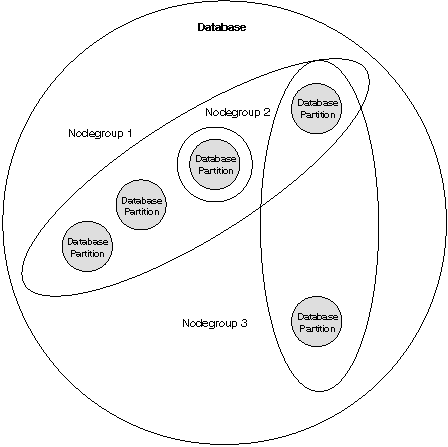

DB2 extends the database manager to the parallel, multi-node environment. A database partition is a part of a database that consists of its own data, indexes, configuration files, and transaction logs. A database partition is sometimes called a node or database node. (Node was the term used in the DB2 Parallel Edition for AIX Version 1 product.)
A single-partition database is a database having only one database partition. All data in the database is stored in that partition. In this case nodegroups, while present, provide no additional capability.
A partitioned database is a database with two or more database partitions. Tables can be located in one or more database partitions. When a table is in a nodegroup consisting of multiple partitions, some of its rows are stored in one partition and others are stored in other partitions.
Usually, a single database partition exists on each physical node and the processors on each system are used by the database manager at each database partition to manage its part of the database's total data.
Because data is divided across database partitions, you can use the power of multiple processors on multiple physical nodes to satisfy requests for information. Data retrieval and update requests are decomposed automatically into sub-requests and executed in parallel among the applicable database partitions. The fact that databases are split across database partitions is transparent to users of SQL statements.
User interaction is through one database partition. It is known as the coordinator node for that user. The coordinator runs on the same database partition as the application, or in the case of a remote application, the database partition to which that application is connected. Any database partition can be used as a coordinator node.
You can define named subsets of one or more database partitions in a database. Each subset you define is known as a nodegroup. Each subset that contains more than one database partition is known as a multi-partition nodegroup. Multi-partition nodegroups can only be defined with database partitions that belong to the same instance.
Figure 2 shows an example of a database with five partitions in which:
Figure 2. Nodegroups in a Database
 |
You create a new nodegroup using the CREATE NODEGROUP statement. Refer to the SQL Reference for more information. Data is divided across all the partitions in a nodegroup. If you are using a multi-partition nodegroup, you must look at several nodegroup design considerations. For more information in both of these areas, see Designing Nodegroups.